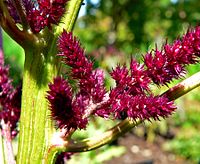17:
97:. As a food oil, amaranth oil has a delicate taste. The oil content of the actual amaranth grain ranges from 4.8 to 8.1%, which is relatively low compared to other sources of seed oil. The melting point of amaranth oil is −27 °C (−17 °F).
73:
having the highest proportions. The oil is valued for its ability to add temperature stability at both high and low temperatures. Commercial uses of amaranth oil include foods,
228:
Budin, J.T.; Breene, W.M. & Putman, D.H (1996). "Some compositional properties of seed oils of eight
Amaranth species".
46:
57:
Amaranth oil is a light-to-medium-colored, clear liquid that is pourable at low temperatures. It is a source of
277:
272:
94:
282:
40:
245:
177:
Martirosyan, D. M; Miroshnichenko, L. A; Kulakova, S. N; Pogojeva, A. V; Zoloedov, V. I (2007).
16:
210:
237:
200:
190:
86:
205:
178:
51:
266:
138:
118:
70:
66:
249:
148:
256:
Interactive
European Network for Industrial Crops and their Applications: Amaranth
128:
108:
62:
58:
34:
90:
82:
74:
255:
214:
195:
241:
78:
179:"Amaranth oil application for coronary heart disease and hypertension"
30:
100:
Chemically, the major constituents of amaranth oil are:
29:is extracted from the seeds of two species of the
230:Journal of the American Oil Chemists' Society
8:
204:
194:
104:
15:
166:
81:, and intermediates for manufacture of
172:
170:
7:
14:
50:— that are called, collectively,
1:
183:Lipids in Health and Disease
152:
142:
132:
122:
299:
23:
196:10.1186/1476-511X-6-1
95:surface active agents
19:
89:, rubber chemicals,
21:Amaranthus cruentus
242:10.1007/BF02523922
47:A. hypochondriacus
24:
157:
156:
290:
258:
253:
225:
219:
218:
208:
198:
174:
105:
298:
297:
293:
292:
291:
289:
288:
287:
263:
262:
261:
227:
226:
222:
176:
175:
168:
164:
87:pharmaceuticals
12:
11:
5:
296:
294:
286:
285:
280:
278:Vegetable oils
275:
265:
264:
260:
259:
236:(4): 475–481.
220:
165:
163:
160:
159:
158:
155:
154:
151:
145:
144:
141:
135:
134:
131:
125:
124:
121:
115:
114:
111:
52:amaranth grain
13:
10:
9:
6:
4:
3:
2:
295:
284:
281:
279:
276:
274:
271:
270:
268:
257:
251:
247:
243:
239:
235:
231:
224:
221:
216:
212:
207:
202:
197:
192:
188:
184:
180:
173:
171:
167:
161:
150:
147:
146:
140:
139:Palmitic acid
137:
136:
130:
127:
126:
120:
119:Linoleic acid
117:
116:
112:
110:
107:
106:
103:
102:
101:
98:
96:
92:
88:
84:
80:
76:
72:
71:palmitic acid
68:
67:linoleic acid
64:
60:
55:
53:
49:
48:
43:
42:
37:
36:
32:
28:
22:
18:
273:Cooking oils
233:
229:
223:
186:
182:
149:Stearic acid
99:
56:
45:
39:
33:
27:Amaranth oil
26:
25:
20:
59:fatty acids
41:A. cruentus
283:Amaranthus
267:Categories
162:References
129:Oleic acid
109:Fatty acid
83:lubricants
63:oleic acid
35:Amaranthus
254:Cited in
91:aromatics
75:cosmetics
250:84760918
215:17207282
113:Content
79:shampoos
206:1779269
61:, with
248:
213:
203:
93:, and
69:, and
246:S2CID
189:: 1.
31:genus
211:PMID
143:19%
133:23%
123:50%
44:and
238:doi
201:PMC
191:doi
153:3%
269::
244:.
234:73
232:.
209:.
199:.
185:.
181:.
169:^
85:,
77:,
65:,
54:.
38:—
252:.
240::
217:.
193::
187:6
Text is available under the Creative Commons Attribution-ShareAlike License. Additional terms may apply.
